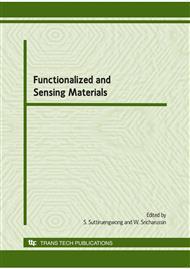p.475
p.479
p.485
p.489
p.493
p.497
p.501
p.505
p.509
Investigation of Oxygen Contamination in Indium Nitride Thin Film by X-Ray Absorption Fine Structure
Abstract:
Local structures of indium oxynitride (InON) nano-crystal prepared by reactive gas-timing RF magnetron sputtering technique are under investigation. Since the optical properties of these InON thin films depend on gas-timing ratio, the local structure analysis is needed in order to determine the relation between the gas timing ratio and its optical properties. In this work, InON thinfilm with 30:0 seconds (N2:O2) gas-timings ratio was analyzed for its local structure using X-ray absorption fine structure (XAFS) technique in conjunction with first principle calculation. The results indicate that the crystal structure of the film is wurtzite structure which is a typical structure of InN. However from the results of Auger Electron Spectroscopy (AES), there are oxygen contents in the film. Since XAFS analysis confirmed the 4-fold local structure of Indium atom, these oxygen atoms must be substituted in nitrogen sites with slightly changing the local structure of Indium atom. The best fit of XAFS data indicated that there is an oxygen atom substituted in nitrogen site of the 4-fold indium.
Info:
Periodical:
Pages:
493-496
Citation:
Online since:
January 2010
Price:
Сopyright:
© 2010 Trans Tech Publications Ltd. All Rights Reserved
Share:
Citation:


